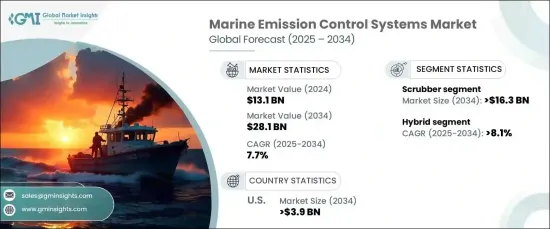
세계의 선박용 배출 가스 제어 시스템 시장은 2024년에 131억 달러에 달하며, 2025-2034년에 CAGR 7.7%로 성장할 것으로 예측됩니다. 이러한 시스템은 황산화물(SOx), 질소산화물(NOx), 입자상 물질(PM), 온실 가스(GHG) 등 선박 배기가스에서 배출되는 유해한 배출물을 줄이기 위해 설계되었습니다. 이러한 오염 물질을 처리함으로써 선박이 세계 및 지역 환경 규제를 충족하고 보다 깨끗한 선박 운항을 촉진할 수 있도록 돕습니다.

첨단 배출가스 제어 기술의 지속적인 개발은 시장 성장을 더욱 촉진할 것으로 예상됩니다. 시스템 효율성 향상, 운영 비용 절감, 설치 프로세스 간소화를 위한 기술 혁신은 보다 폭넓은 채택을 촉진할 것으로 보입니다. 또한 개방형 및 폐쇄형 루프 구성으로 작동할 수 있는 하이브리드 스크러버와 미립자 물질을 제거하도록 설계된 습식 전기집진기(WESP)와 같은 신기술은 배출가스 제어 솔루션을 보다 효율적이고 비용 효율적으로 만들어 시장 환경을 강화할 것으로 예상됩니다. 시장 환경을 강화할 것으로 예상됩니다.
| 시장 범위 | |
|---|---|
| 시작연도 | 2024년 |
| 예측연도 | 2025-2034년 |
| 시작 금액 | 131억 달러 |
| 예상 금액 | 281억 달러 |
| CAGR | 7.7% |
시장은 선택적 촉매환원, 스크러버, 전기집진장비, 기타 등 기술별로 구분됩니다. 이 중 스크러버 분야는 2034년까지 163억 달러 시장을 창출할 것으로 예상됩니다. 저유황 연료유 대신 고황 연료유를 사용하는 등 비용 효율적인 솔루션에 대한 선호도가 높아짐에 따라 스크러버에 대한 수요가 증가할 것으로 예상됩니다. 이러한 시스템의 효율성, 신뢰성 및 사용 편의성을 향상시키는 기술 발전은 이러한 시스템의 보급을 더욱 촉진할 것으로 예상됩니다. 점점 더 엄격해지는 환경 규제 준수를 보장하는 기술 혁신은 시장의 범위와 용도를 확대할 것으로 예상됩니다.
연료 유형에 따라 시장은 선박용 디젤유, 선박용 가스유, 하이브리드 연료, 기타로 분류됩니다. 하이브리드 분야는 2034년까지 8.1%의 연평균 복합 성장률(CAGR)을 나타낼 것으로 예상됩니다. 이러한 성장은 하이브리드 연료와 관련된 황산화물(SOx), 질소산화물(NOx), 입자상 물질(PM)의 배출량이 적기 때문입니다. 하이브리드 시스템은 저유황 연료로의 전면적인 전환이나 고가의 배기가스 정화 시스템에 대한 투자에 대한 비용 효율적인 대안을 제공합니다. 하이브리드 연료의 가용성이 증가하고 이를 지원하는 인프라가 개발되면 선주들에게 하이브리드 연료의 매력은 더욱 커질 것으로 예상됩니다.
미국의 선박용 배출가스 제어 시스템 시장은 2034년까지 39억 달러 규모 시장을 창출할 것으로 예상됩니다. 이러한 성장의 원동력은 규제기관과 국제 표준에 의해 점점 더 엄격해지는 환경 규제에 기인합니다. 환경 인식이 높아지고 기업의 사회적 책임(CSR)에 대한 관심이 높아짐에 따라 해양 산업에서 지속가능한 관행에 대한 수요는 계속 증가하여 시장 확대에 더욱 기여할 것으로 보입니다.
The Global Marine Emission Control Systems Market reached USD 13.1 billion in 2024 and is projected to grow at a CAGR of 7.7% from 2025 to 2034. These systems are designed to reduce harmful emissions from ship exhausts, including sulfur oxides (SOx), nitrogen oxides (NOx), particulate matter (PM), and greenhouse gases (GHGs). By addressing these pollutants, they help vessels meet both global and local environmental regulations, promoting cleaner marine operations.

The continuous development of advanced emission control technologies is expected to further boost market growth. Innovations aimed at improving system efficiency, lowering operational costs, and simplifying installation processes will drive wider adoption. Additionally, new technologies like hybrid scrubbers, which can operate in both open and closed-loop configurations and wet electrostatic precipitators (WESPs), designed to remove fine particulate matter, are expected to enhance the market landscape, making emission control solutions more efficient and cost-effective.
| Market Scope | |
|---|---|
| Start Year | 2024 |
| Forecast Year | 2025-2034 |
| Start Value | $13.1 Billion |
| Forecast Value | $28.1 Billion |
| CAGR | 7.7% |
The market is segmented by technology, including selective catalytic reduction, scrubbers, electrostatic precipitators, and others. Among these, the scrubber segment is forecast to generate USD 16.3 billion by 2034. The growing preference for cost-effective solutions, such as the use of high-sulfur fuel oil instead of low-sulfur options, will drive demand for scrubbers. Technological advancements aimed at improving the efficiency, reliability, and ease of use of these systems will further support their widespread adoption. Innovations that ensure compliance with increasingly stringent environmental regulations will expand the market's reach and application.
By fuel type, the market is categorized into marine diesel oil, marine gas oil, hybrid fuels, and others. The hybrid segment is expected to experience a CAGR of 8.1% through 2034. This growth is attributed to the lower emissions of sulfur oxides (SOx), nitrogen oxides (NOx), and particulate matter (PM) associated with hybrid fuels. Hybrid systems offer a cost-effective alternative to transitioning entirely to low-sulfur fuels or investing in expensive exhaust gas cleaning systems. The growing availability of hybrid fuel and the development of supporting infrastructure will further enhance its attractiveness to shipowners.
U.S. marine emission control systems market is anticipated to generate USD 3.9 billion by 2034. This growth is driven by increasingly strict environmental regulations enforced by regulatory bodies and international standards. As environmental awareness rises and businesses emphasize corporate social responsibility (CSR), the demand for sustainable practices in the marine industry will continue to grow, further contributing to the expansion of the market.